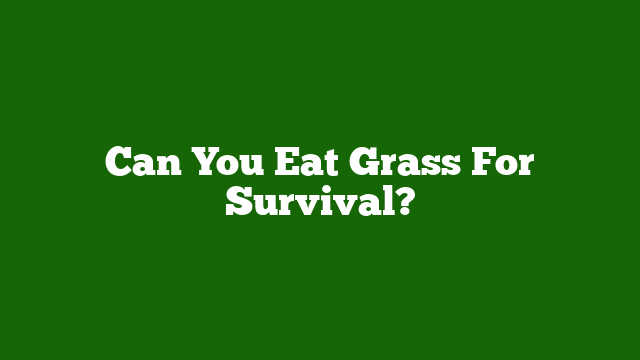Last Updated on June 12, 2023 by Umar
Grass is abundant and can be found in almost every region of the world.
In a survival situation, it might seem like a viable option for sustenance.
However, the question remains: can you eat grass for survival?
This comprehensive guide will provide you with all the information you need to know about grass as a potential survival food.
Why Can’t Humans Eat Grass?
The simple answer is that human digestive systems are not designed to handle the high amount of cellulose found in grass
Cellulose is a complex carbohydrate that forms the cell walls of plants, and humans lack the necessary enzymes to break it downAs a result, grass provides very little nutritional value for humans and can even make people sick if consumed in large quantities.
Grass Nutrition and Potential Hazards
Grass contains virtually no genuine nutrition for humans
At best, consuming grass might fill your belly and temporarily stave off hunger, but it does not provide the necessary nutrients for survival
Additionally, grass is full of silica, which is abrasive and can wear down human teethGrazing animals have teeth that continually grow, allowing them to eat grass without causing serious dental damage.
Furthermore, some grass varieties can be toxic if consumed raw
While it’s possible to find edible wild grasses, it’s challenging and not worth the risk in a survival situation
.
Cooking Grass and Other Processing Methods
Cooking grass does not make it safe to eat
Even when cooked, the cellulose in grass remains indigestible for humans
There is no known method of preparing grass that makes it safe or nutritious for human consumption.
Grass Seeds and Sprouts
While grass stems and leaves are not suitable for human consumption, grass seeds can provide some nutrition
However, in a survival situation, it’s unlikely that you would spend hours harvesting tiny grass seeds that would only sustain you for a short period
Sprouting the seeds can increase their nutritional value, but this can be challenging if you’re constantly on the move or have limited water supply.
Alternatives to Grass in a Survival Situation
In a survival scenario, it’s essential to focus on finding alternative food sources that provide the necessary nutrients for survival.
Foraging for edible plants, hunting or trapping animals, and fishing are all viable options for obtaining sustenance in the wild.
Conclusion
Grass is not a suitable food source for humans in a survival situation.
The human digestive system cannot break down the cellulose in grass, providing little to no nutritional value and potentially causing harm.
Instead, focus on finding alternative food sources that can provide the necessary nutrients for survival.

